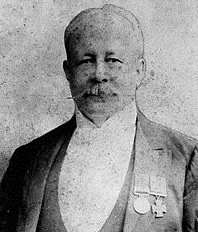 Patented in 1896 and going into production in 1901, the Webley-Fosbery Automatic Revolver was the brainchild of British Col. George Vincent Fosbery, VC. Fosbery was a career military officer who had served in India for many years (and won his Victoria Cross there in 1863). He was also an avid fan of guns and firearm technology, and the Webley-Fosbery was only one of his several relatively successful inventions (others include an exploding bullet used largely for range-finding and the Paradox system for shooting shot or ball relatively accurately through the same barrel).
Patented in 1896 and going into production in 1901, the Webley-Fosbery Automatic Revolver was the brainchild of British Col. George Vincent Fosbery, VC. Fosbery was a career military officer who had served in India for many years (and won his Victoria Cross there in 1863). He was also an avid fan of guns and firearm technology, and the Webley-Fosbery was only one of his several relatively successful inventions (others include an exploding bullet used largely for range-finding and the Paradox system for shooting shot or ball relatively accurately through the same barrel).
Fosbery’s rationale for the self-cocking revolver was a search for a sidearm that would combine the rapid fire and crisp trigger of the automatic pistol with the heavy .455 cartridge of the British service revolver. The automatic pistols available in the late 1890s were virtually all chambered for rather small cartridges, and Fosbery believed that large projectiles were much better suited to combat (proving in addition that nothing changes over time, as this theory and its opposite continue to be argued back and forth to this day). So Fosbery devised a way to harness the recoil energy of a revolver to recock the hammer and rotate the cylinder. His initial model was based on a Colt SAA, but after finding Colt uninterested in the idea he began working with the Webley company, and his production guns are based on their standard revolver.
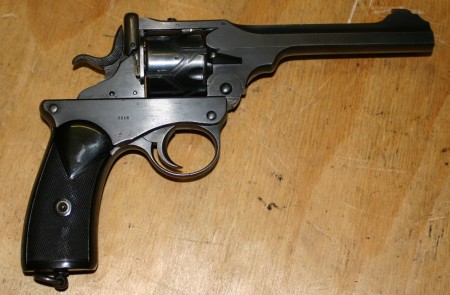
Mechanically, the Webley-Fosbery operates by virtue of the barrel and cylinder assembly being independent of the grip assembly, the one riding in grooves machined into the other. Thus when fired, the grip stays in place and the barrel and cylinder assembly slides back, while a cam pin running in the conspicuous cylinder grooves rotates it to the next chamber and recocks the hammer.\
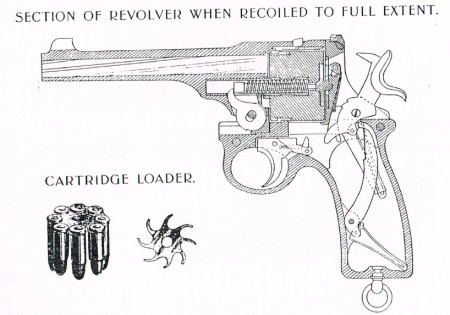
This system worked well when clean, and gave a shooter a constant single-action trigger pull, a full-power .455 service cartridge, the capacity for quite rapid fire (as fast as any semiautomatic pistol), and also absorbed some of the recoil from that relatively large cartridge.
The Webley-Fosbery is one of the few revolvers to feature a manual safety, which was necessary because of its manual of arms. The trigger mechanism was single action only – so you could not carry it with the hammer down and fire by just pulling the trigger. Instead, the piece needed to be cocked (either by the hammer alone or by manually pushing the upper assembly back to mimic firing) and carried with the hammer back. To make this safe, a manual safety lever on the left side of the grip could be engaged, which would lock the trigger and the sliding frame both in place.
To empty spent cases and reload, the procedure was identical to a typical Webley revolver. A lever just to the left of the hammer would allow the action to break open (pivoting around the bolt located in front of and below the cylinder), and an automatic ejector would push out all the empty cases. Reloading a .455 model could be done one round at a time, or with a Prideaux speed-loader.
Cartridges
The Webley-Fosbery was available in two different cartridges; .455 and .38. It is often assumed that the .38 caliber guns used .38-200 (aka .38 S&W) ammunition, because this was the round used in standard .38 caliber Webley revolvers – but that assumption is incorrect. The .38-200 was not adopted by the British military until the 1920s, while the .38 ACP was a hot new item in the American market, having been introduced in 1900. It was this .38 ACP round that was used by the smaller caliber Webley-Fosberys, using 8-round moon clips (see cutaway diagram above). The design of those moon clips was a bit different than what we are used to seeing today, with a pointed spiral sort of shape. You can see the cut-out area in the cylinder for the clips in this factory nickel-plated example:
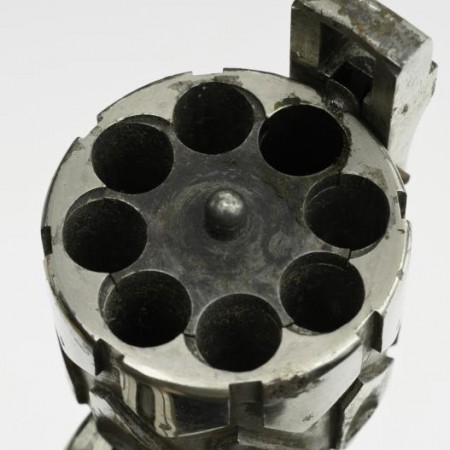
The more common caliber for the Webley-Fosbery was the .455 British service round, which did not use a clip. In that caliber, the weapon had a 6-round cylinder.
Variations
At the time of its introduction, British officers supplied their own sidearms, and were required only to use the standard cartridge, so more than a few chose to purchase .455 Webley-Fosbery automatic revolvers, although the gun was never formally adopted. The most common model was a 6″ barrel and blued finish, but Webley was willing to make the guns in several other configurations. One could buy the gun with a 4″ or 7.5″ barrel as well as the 6″, and they could also be supplied with multiple barrels for the enthusiast who wanted a target option as well as a more conveniently sized version to carry. Nickel finish was an option (not many produced this way, though). The longer target barrel were also set up with sights more styled for competition, as the Webley-Fosbery was noted as a quite effective competition gun at the time.
Overall production was approximately 4200 pistols, although serial numbers go to approximately 4500 (a few blocks of numbers were skipped), and the vast majority of these were in .455 caliber. Only 417 were originally produced in .38 ACP, and 141 of those were dismantled at the factory and used for parts. Another 72 (at least) were converted to .455 at the factory, and thus no more than about 200 left the shop – making the .38 caliber Fosbery pistols particularly valuable today. Given that the main market was military, this caliber discrepancy should not be particularly surprising.
Production ran from 1901 until 1924, generally at a rate of 10 guns per week, although there were periods where none were being made (such as during WWI, when production of standard Webley revolvers had much higher priority).
Epilogue
The Webley-Fosbery had a following of both target shooters and Army officers, but it was ultimately not hugely successful and is remembered today promarily because of its unique mechanism. The guns were used by British pilots before machine guns became commonplace aircraft armament and they served well enough in that capacity. They were used by infantry officers in WWI and worked fine as long as they were kept relatively clean, but the sliding recoil mechanism was prone to becoming incapacitated by dirt or debris.
The Webley-Fosbery was submitted to the US pistol trials of 1907, where it was rather quickly discarded as not offering any useful advantages to offset its bulk and susceptibility to fouling. Of course, the US trials stipulated a .45 caliber cartridge, so Fosbery’s original goal of improving on the 6mm and 7mm early pistol cartridges already met.
Manuals
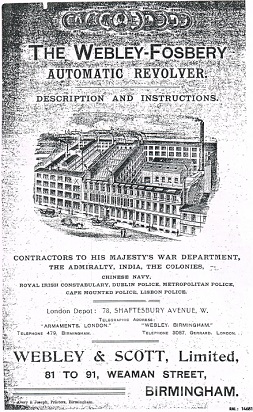

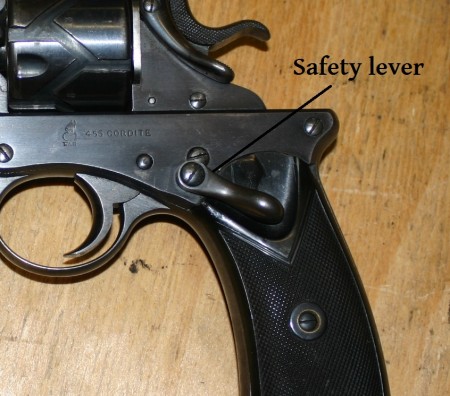
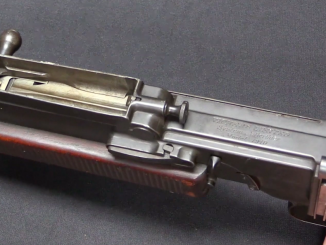

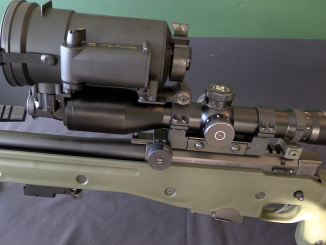
Awesome post of an interesting firearm! And even more, that’s a Webley manual I don’t have! Thanks!
Hey, you forgot Zardoz. That was a cool movie that featured the Fosbery.
Also didn’t one of Walter Mitty’s alter egos declaim in open court, ‘With my right arm in a sling I could have shot the deceased at 200 paces with my left hand.’
It would be an interesting concept today if a semi-auto revolver were basically a striker fired design that was not a true single action, but took maybe 5-7 lbs to fire, and dispense with the manual safety. That would give the simplicity and reliability of a revolver, but with an easier trigger. Advantage over semi-autos would include being able to use cartridges not suited for (non-novelty) auto loaders (e.g., .44 spl or mag). Advantage over a traditional revolver would be less recoil and a better DA trigger. S&W N frame meets Glock.
I believe this is the gun you’re looking for, more or less: https://en.wikipedia.org/wiki/Mateba_Autorevolver
The Chiappa Rhino looks suspiciously similar to the Mateba…noticed THAT the first time I saw a Rhino…anyone know if there IS a connection???
CB in FL
Same designer, who seems to have made it his goal never to make a ‘normal’ looking firearm- http://matebafan.com/
That is interesting, it looks like it goes single action with a safety, but not sure from the link. Something more like a half cock with a transfer bar safety would be really interesting, perfectly safe but easier than a normal DA pull. If one was in bear country it would be a great set up. It would be justification for a revolver versus a semi-auto.
I would prefer the original mechanism – the revolver HAS a safety – one of the few to ever have a manual safety…usually only found in cheap detective novels or on TV shows.
CB in FL
I believe the Webley Fosbery is mentioned in “The Secret Life of Walter Mitty” and the 8 shot .38 version was used to ‘off’ Sam Spade’s partner in the “Maltese Falcon”.
I’ve been searching for one of these for 15 years, and only found 4 that were functional and as the old saying goes “only way to come away with one of these and still have a small fortune is GO WITH A BIG ONE!” Probably rank even in dollars with a Colt U.S. Cav 7.5″ 1873 in good condition.//
A collector in our WPB club who specializes in esoteric firearms and militaria has, IIRC, 6 of the W-Fs in .38!!!
CB in FL
hahahaha YEA there are people like that, very bad about sharing!!! LoL
They might be coming back into production…
http://oldbritishguns.com/438-the-phsadc-webley-fosbery
Yep, I saw that. I’m working on getting a sample to test and review; we’ll see if that works out.
Count ME in !!!
Awesome…
Whoa! Their .38 version is an eight shot!
On a related topic, as I was researching the Webley-Fosbery I ran across this patent for a multiple revolving barrel .22cal SMG called the Neal Submachinegun, which seems to function along a similar principle, although fed from a helical magazine (no idea how that works).
http://www.google.com/patents?id=3DhMAAAAEBAJ&pg=PA1&source=gbs_selected_pages&cad=2#v=onepage&q&f=false
I don’t believe it was ever actually built, but the design looks very interesting.
Sheepishly just noticed that the original W/F was an eight-shot. Just ignore me!
So the Webley-Fosbury was also made in .38 ACP. Which means it can be loaded with the .38 Super. Scary.
Not .38 ACP …. .38 revolver cartridge (essentially a British military version of the .38 Smith & Wesson.
There is hope for those of us who have always wanted one of these revolvers – Webley-Fosbery clones are apparently in production in Pakistan (or soon to be in production) in both .455 and .38 chamberings, under the auspices of the Pakistan Hunting & Sporting Arms Development Corporation. Look here: http://oldbritishguns.com/phsadc-webley-fosbery
PHSADC have a Facebook “showcase” page …. I encourage all and sundry to go there, search out the posting on the Webley-Fosbery clones, and post encouraging “Likes” and comments. Actually, they have advised someone I know that these revolvers should be available through a US distributor fairly soon, in the price-range of about US$800 …. https://www.facebook.com/pages/Pakistan-Hunting-Sporting-Arms-Development-Company-Phsadc/179036122242220
It’s surprising, but the .38 Webley-Fosberys really were in .38ACP. That was the hot new military cartridge at the time. Notice that the .38s always came with full-moon clips, which would not have been required or even usable with rimmed cartridges.
Oops, I just noticed that the oldbritishguns link was already posted above. However, hopefully the PHSADC Facebook page will get some encouraging visits.
Also, I was looking for some slow-motion footage of a Webley-Fosbery revolver being fired …. and finally found some in a rather odd video showing iphones being blasted with bullets (…. ? …) If you want to cut directly to the chase in this video of a bit over 3 minutes, go to about the 45 second point …. http://revision3.com/ratedrr/ipod-touch-5th-generation
That’s some great video – thanks!
I stand corrected on the .38 model! I guess I was jumping to conclusions, knowing that the .455 was chambered for the revolver cartridge ….
Back in Viet Nam I often flew with the Hughes Mk.4 Gun Pods. The rear half was full of ammo and the front half was a high-speed 20mm cannon. Unlike the Vulcan Gatling Gun which uses six electrically driven rotating barrels, the Hughes had 2 over-under fixed barrels fed by an 8-chamber revolving cylinder recoil-operated just like the Webley-Fosbery Automatic Revolver. They said that the Vulcan can shoot 6,000 rpm while the Hughes can shoot 4,000 rpm, but while the Hughes delivers its max rate instantly, the Vulcan has to “wind up” for a second or two to its max rate. A bit of trivia – the Hughes have smoothbore barrels – the spin-stabilization is provided with rifling within the chambers of the cylinder, actually.
I have an old 455 caliber 6 shot Webley hand gun that looks nothing like the 1907 Webley-Fosbery. The cylinder slides forward to load after you release the trigger guard. The only number on the gun which is on the gun barrel is 687. There is an oval circle on the cylinder with the letters E over LG with a 5 point star under the letters. There is a British stamp or emblem above all this. The hand grips look to be made out of Walnut with a lanyard ring on the bottom. This gun would fire as fast as you could pull the trigger. I have had several friends that collect guns and none of them has had any luck finding out how old it is or the model. I would like to sell it but need to know just what I have here and what it might be worth. Would appreciate any info. Thanks.
Attract Girl~~Seeking for Life Long Partner? Looking for Men with Similar Background and Interest. Meet Them Today at Local Singles! Sign Up Now!: http://www.lucksh.gq
come dimagrire in 3 settimane http://www.lucksh.ga/3witaly/